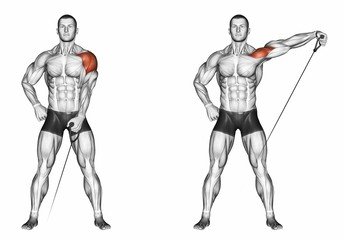Master the Cable Lateral Raise – Key for Stronger, Wider Shoulders
Contents
What is the Medial Deltoid Muscle?
The cable lateral raise primarily targets the medial deltoids, which are key for building wider, more defined shoulders. It’s between the anterior and posterior deltoids, the medial deltoid is the outer part of the shoulder, giving it that rounded, sculpted shape. Its main job? It moves your arm away from your body. (And no, this has nothing to do with the medial deltoid ligament in your foot, so no need to go googling foot anatomy here)

Why the Cable Lateral Raise Works
The only things that should be moving are your arm and shoulder. If you’re twisting or flailing to hoist that weight, you’re probably lifting too much—drop the ego and focus on the target muscle!
The cable lateral raise mimics the natural movement of the medial deltoid while adding the challenge of constant tension from the cable. This makes your shoulders stronger and more defined over time. The cable keeps your delts working throughout the full range of motion. If you’re aiming for that ‘capped’ shoulder look that turns heads at the gym, this exercise is your friend.
Start light, get the form down, and progressively increase the weight as you grow stronger. The key to mastering this move is getting a good stretch at the top and controlling the ascent and descent to maximize time under tension.
How to Perform the Cable Lateral Raise
- Choose a light weight to start. We’re working on form, not trying to win a strongman competition just yet.
- Position the cable near the floor. This sets you up for that perfect range of motion.
- Stand to the side of the cable machine. The cable machine isn’t going anywhere, but you should be in prime position.
- Chest out, shoulders back, knees slightly bent. You’re basically striking a confident superhero pose.
- Use your free hand for support. Hold the machine with your non-working hand for stability, forming a ‘T’ shape with your body.
- Lift the cable outward. Start the movement with the cable near your knee and raise it diagonally, extending your arm up for a nice stretch.
- Slowly lower the cable. And repeat, repeat, repeat.

Cable Lateral Raise vs. Dumbbell Lateral Raise: Which is Better for Shoulder Growth?
There’s a lot of debate online on which is better—cable lateral raises or dumbbell lateral raises?” The truth is, both exercises target the same muscle, the medial deltoid, but the difference lies in how each exercise delivers tension to the muscle. Let’s break it down:
Muscles worked with Dumbbell Lateral Raise
With dumbbells, gravity is your main opponent. The resistance is heaviest at the top of the lift (when your arms are parallel to the ground), but as you lower the weight, gravity pulls the dumbbells straight down, meaning less tension on the delts at the bottom.
- Strength in the mid-range: You’re getting the most tension when your arms are at shoulder height, which is great for building strength at that point in the movement.
- More natural movement: Because you’re not restricted by a machine, dumbbells allow a more natural path of movement. You can slightly rotate your arms to hit the delts in a way that feels most comfortable.
- Easy to adjust weights: You can quickly switch between different dumbbell weights, making it convenient for progressive overload.
Muscles worked with Cable Lateral Raise
Cables, on the other hand, provide constant tension throughout the entire range of motion. Unlike dumbbells, where you lose resistance at the bottom, the cable keeps your medial delts engaged the entire time, from the start of the movement to the top.
Muscles worked with Cable Lateral Raise
- Constant tension: No matter where you are in the lift, the cable is pulling against you, making this a more challenging movement from start to finish.
- Better for a full range of motion: Since the tension never lets up, you can focus on controlling the entire movement. This makes it easier to focus on building that mind-muscle connection and hitting the delts more effectively.
- Adjustable angles: By changing the height of the cable, you can vary the angle of resistance to target your delts from different points. Want to emphasize the stretch at the bottom? Lower the cable. Need more emphasis at the top? Raise it higher.
Which One Should You Choose?
It’s not a matter of “either-or,” but more of “why not both?” Dumbbells are great for beginners or those looking for a simple, effective way to work the medial deltoid. They’re a classic. But cables? They’re a game-changer when you want to really dial in that full range of motion and keep tension constant.
If you’re in a rush or don’t have access to a cable machine, grab some dumbbells and go for it. But if you’re looking to level up your shoulder training and really focus on sculpting that rounded look, cables are a fantastic option.
Workout Tip: Try alternating between the two in your workout routine. Start with cables for that constant tension, then finish with dumbbells to push your delts to fatigue. Your shoulders will be on fire—in the best way possible!